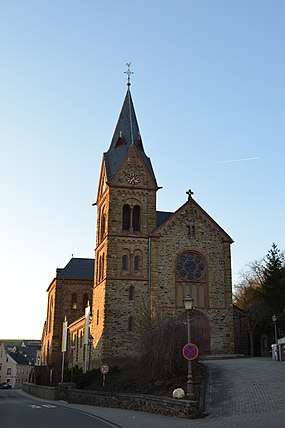Parish Church St. Petrus (Eisenbach)
| Parish Church of St. Peter | |
|---|---|

|
|
| place | Eisenbach , Limburg-Weilburg district , Hesse |
| religion | Roman Catholic |
| Diocese | Diocese of Limburg |
| Church building | |
| design type | Cross basilica |
| Construction year | 1896-1898 |
| builder | Jacob Fachinger |
| Steeple | South tower |
The Roman Catholic parish church of St. Petrus is a listed church building in Eisenbach im Taunus ( Limburg-Weilburg district ).
prehistory
A smaller church, built in the years 1711–1712, previously stood on the site of today's church. The choir and the tower of this church came from the previous church, which was probably built in the 12th / 13th centuries. Century should be built. The longitudinal axis of both churches ran in a west-east direction, i.e. in the direction of the transept of today's church, with the choir and altar on the east side. The tower was built above the choir vault and therefore stood right next to the hillside of the vineyard. This new building was started on April 20, 1711 and completed on August 31, 1712. The new nave was built around the old one and only after its completion was the old church demolished except for the tower. The new church was 95 feet long, of which the nave was 80 feet, and the choir, high altar and sacristy comprised 15 feet. It was approximately 25 feet wide, giving an external floor plan of approximately 10.5 × 22.5 m. The tower was about 100 feet high, of which 40 feet were bricked on four sides and an octagonal pyramid rose on top of it, which was covered with slate.
Already in 1830 the diocese was complained about the bad condition of the church. In the flying buttress of the ancient tower there was not just a vertical, but an oval crack. Obviously, this structural damage was largely repaired in the next few years. In 1883 the diocese was again approached, as the parish church was far too small for the large number of believers.
History and architecture
When the new chaplain Clemens Langenhof came to Eisenbach on November 27th, 1884, he must very soon have recognized the misery surrounding the existing church and worked hard to build a new church. In January 1886, still as a chaplain, he told the episcopal ordinariate that the parish of Eisenbach was forced to start building a new church very soon. In the winter of 1895/1896 the architect Jacob Fachinger from Limburg made the final construction plans and the cost estimates. On August 25, 1896, the foundation and foundation work began in the area outside the old church. On Ascension Day in 1897, the foundation stone was built. The shell was completed in December 1897. On Sunday, September 25th, 1898, the largest and most beautiful church on the Golden Ground was inaugurated by Bishop Dominikus Willi .
Architect Jacob Fachinger built the church in the neo-Romanesque style , which with its tower still strongly shapes the townscape today. In the 1950s and 1970s, the church was extensively renovated and adapted, among other things, to the liturgical requirements of the 2nd Vatican Council.
organ
In 1972, today's sparked organ of the company Späth from the old, built in 1949, the organ of the organ builder Wagenbach from Limburg with its 18 registers and 1,332 pipes. The new organ has a prospectus that allows the effect of the large rose window in the portal wall to come into its own again and fits in harmoniously with the lines. It is characterized by a perfect sound.
Bells
When the new church was built, the bells and their origins were not mentioned in detail. The bells from the old church were probably taken over when the new church was built. There were probably four bells, because three of them were confiscated for armaments purposes during the First World War , and one, the so-called school bell, remained. In 1923 three new bells in the tones f, c sharp and a sharp were purchased. The owner of the Hof zu Hausen donated a bell . In the Second World War , the bells had to be used again except for one for the manufacture of cannons. In 1952, three bells in the tones f sharp ', g sharp' and c sharp '' were purchased in addition to the existing bell in a sharp 'with an electric bell. These were supplied by the Franz Otto company in Hemelingen near Bremen , where the previous bells were also cast. The bells have the following diameters: 1160 mm, 1030 mm, 920 mm, 810 mm. They weigh 980 kg, 720 kg, 480 kg, 290 kg.
Web links
- State Office for Monument Preservation Hessen (Ed.): Catholic Parish Church St. Petrus In: DenkXweb, online edition of cultural monuments in Hessen
- Pastoraler Bad Camberg, section parish church St. Petrus Eisenbach
literature
- Heimatbuch 750 years Eisenbach 1234–1984, Meinerzhagen printing and publishing house, Meinerzhagen May 1984.
- Limburg Bell Book. Bells and chimes in the Diocese of Limburg. Foersch, Hubert, Limburg 1997.
Individual evidence
- ↑ a b c d Franz-Josef Rembser: 750 years of Eisenbach 1234–1984 - From the history of the Catholic. Eisenbach parish .
- ^ Gerhard Reinhold: Otto Glocken - family and company history of the bell foundry dynasty Otto . Self-published, Essen 2019, ISBN 978-3-00-063109-2 , p. 588, here in particular p. 550 .
- ↑ Gerhard Reinhold: Church bells - Christian world cultural heritage, illustrated using the example of the bell founder Otto, Hemelingen / Bremen . Nijmegen / NL 2019, p. 556, here in particular p. 508 , urn : nbn: nl: ui: 22-2066 / 204770 (dissertation at Radboud Universiteit Nijmegen).
Coordinates: 50 ° 20 ′ 6 ″ N , 8 ° 13 ′ 27 ″ E
